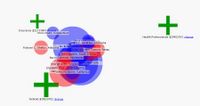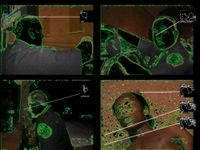Is Innovation Declining?
Are we on our way back to the Dark Ages?
Recent research has shown that the rate of invention per person peaked in 1915 and has been declining ever since.
In a study of major innovations over time and population, analysis shows that we are in a major decline.
This conclusion is opposite of the widely held belief that we are experiencing exponential growth in technology and innovation.
The complete study will be published in Technological Forecasting and Social Change. I will discuss it in more detail after I have read the paper.
Read more...
Are we on our way back to the Dark Ages?
Bird's Eye View
Nissan is working on an advanced system for totally eliminating blind spots while driving, providing the driver with a view that looks likes video from 50 feet above the car looking down. The illusion is created with a computer that synthesizes video from side, front and rear cameras into a real-time image that looks like a birds-eye view. Nissan Presage cars have sported left and right cameras for two years -- future models will get the addition of front and rear cameras, plus the computerized display.

Birds Eye View
Raw FeedCombined with surveillance cameras you could see around corners too.
Are You Ready For Nanofood?
Nanoscientists and food industry specialists are meeting right now at
Nano4Food 2005, a conference held in Wageningen, The Netherlands, on June 20-21. They will discuss how nanotechnology can help food processing companies to improve the safety and quality of their products by using nanosensors and diagnostic machines. But, in
this article, FoodProductionDaily.com writes that there is another subject on the agenda. New kinds of foods, embedded with nanoparticles, could one day deliver their contents in our bodies, such as medicines or nutrients. So far, food companies are only investigating, and no product has been released yet. But technology is almost ready for these companies to sell you interactive drinks you can play with, changing colors or textures. Read more...
Are You Ready For Nanofood?
First nanofluidic transistor
Researchers create first nanofluidic transistor, the basis of future chemical processors
By Robert Sanders, Media Relations | 28 June 2005
BERKELEY – University of California, Berkeley, researchers have invented a variation on the standard electronic transistor, creating the first "nanofluidic" transistor that allows them to control the movement of ions through sub-microscopic, water-filled channels.
The researchers - a chemist and a mechanical engineer - predict that, just as the electronic transistor became the main component of microprocessors and integrated circuits, so will nanofluidic transistors anchor molecular processors, allowing microscopic chemical plants on a chip that operate without moving parts. No valves to get stuck, no pumps to blow, no mixers to get clogged.

nanofluid transistor
"A transistor is like a valve, but you use electricity to open or close it," explained Arun Majumdar, professor of mechanical engineering at UC Berkeley. "Here, we use a voltage to open or close an ion channel. Now that we've shown you can make this building block, we can hook it up to an electronic chip to control the fluidics."
If the ions are proteins, they can be shuttled through channels lined with fluorescent antibodies for detecting or sensing. If the ions are pieces of DNA, they can be sorted and sequenced. In fact, the authors say, any highly sensitive biomolecular sensing down to the level of a single molecule could be performed with nanofluidic transistors. They demonstrated that labeled, charged DNA fragments could be manipulated in their transistor.
06.28.2005 - Researchers create first nanofluidic transistor, the basis of future chemical processorsThis technology will be a big step in converting electrical - digital - information into useable matter. An important step in future artifacturing applications.
Our Universe: The Formative Years
A computer simulation of the growth years of our universe. The simulation explored the model from an age of tem million years to today at 13 billion years old.
A Code for the Heavens
By Michael Schirber
Staff Writer
posted: 27 June 2005
The so-called "Millennium Run" took 28 days of intense computation to generate its 25 terabytes (25 trillion bytes) of data. The simulation – named after the 2000-time-frame in which the idea was conceived – tracks the evolution of matter inside a cube 2 billion light-years on a side.

210 million years
The simulation starts when the universe was 10 million years old and evolves it all the way to the present – 13 billion odd years later. The cube contains roughly 10 billion "particles" – each with the mass of a billion Suns. These colossal blobs of matter interact gravitationally with each other in cyberspace.

4.7 billion years
Gravity will cause some of the particles to merge. In the center of these matter clumps, galaxies can form, but exactly what type of galaxy will depend on the size of the clump and the history of mergers. It would take a clump of a few thousand particles to house a Milky-Way-sized galaxy.

13.6 billion years
"The really cool thing is that in the future, when the data is made public, you can go in and insert your own rules for galaxy formation," Evrard said.
This is seen as a much more efficient use of computer time, as different researchers – and the ambitious amateur cosmologist – can use the dark matter skeleton from the Millennium Run to hang their own galaxy models.
"For this reason, the simulation will have staying power," said Evrard. "Maybe not for a millennium," he joked, "but for a decade, at least, and perhaps longer."
A Code for the Heavens
Artifacturing
New weblog dedicated to the process of transforming concepts from the digital domain into solid physical artifacts.
Artifacturing includes stereolithography, 3D printing and other methods that automate the creation of physical parts.

The weblog will go beyond rapid prototyping and industrial uses to focus on new applications and new ideas solidified into artifacts.
 Artifacturing
Artifacturing
Ubiquitous Video Feed
Computer scientists at
University of California, San Diego have developed software to stitch together video sources to create the effect of a flying observer.
Called "RealityFlythrough" the software combines seperate sources into one moving video source.
This would be amazing if it could combine all the survellience cameras along the streets and businesses today.
A possible future for picture phones is that you can pan in on the person talking to you through the public cameras around them. For a sort of over-the-shoulder look. This would be preferable than the view of their face peering through the little window at you.
This software would help make that possible. You wouldn't need to know the IP address of the local cameras, just the location of the caller. You could glance around to see how's the weather, who else is there?
From the UCSD press release:
“Instead of watching all the feeds simultaneously on a bank of monitors, the viewer can navigate an integrated, interactive environment as if it were a video game,” said UCSD computer science and engineering professor Bill Griswold, who is working on the project with Ph.D. candidate Neil McCurdy. “RealityFlythrough creates the illusion of complete live camera coverage in a physical space. It’s a new form of situational awareness, and we designed a system that can work in unforgiving environments with intermittent network connectivity.”
The UCSD researchers say the biggest research challenge was to overcome the limitation of incomplete coverage of live video streams. “Every square meter of a space cannot be viewed from every angle with a live video stream at any given moment,” said Griswold, an academic participant in the California Institute for Telecommunications and Information Technology (Calit2). “We had to find a way to fill in the empty space that would give the user a sense of how the video streams relate to one another spatially.”
Their solution: RealityFlythrough fills in the gaps in coverage with the most recent still images captured during camera pans. The software then blends the imagery with smooth transitions that simulate the sensation of a human performing a walking camera pan – even when one of the images is a still-frame. If older images are not desirable (e.g. in some security applications), the fill-in images can be omitted, or shown in sepia, or include an icon displaying how old the photo is.
News Releases
Influence State Machine
The State machine is a flash display that shows the influence of money on US senators.
Each senator is representated by a circle. The more money, the bigger the dot. Their color shows party affiliation.

You can change and move around symbols to see who is paying who. The dots will be attraqcted to their biggest supporters.
via
we make money not artPlay with it...http://state-machine.org/agency/
Automated TV Watcher
Automated surveillance of surveillance of surveillance.
I like to watch / CopVision is a program that watches television. Specifically, it watches COPS on Fox. It is not a video, it is a software process that tries to make sense of a live video feed. COPS is all it has ever known, and it probably thinks it is COPS. It has started to watch television as the show.
CopVision learns its language from closed captioning subtitles transmitted in the television signal. Everything that is said on COPS is tucked away in its memory to help it understand what it's seeing. It analyzes every frame, searching the field for outlines that remind it of something it has seen before. When it recognizes a contour it tags it with a guess as to what might be going on, gathered from its experience of words and pictures that go together. It sometimes tries to put words in the mouths of the characters. CopVision is funny when commercials come on because it doesn't know that it isn't COPS, and it keeps watching the same way.

CopVision, like COPS, has no irony. It does its level best in every circumstance to do its duty. That its understanding of the world of COPS falls short can be taken as a comment either on what is missing from the show or what is lost in the process of extraction of meaning. It's both of course, but they compound in unpredictable ways.
Through projects like I Like to Watch / CopVision, it has become possible to imagine a day when automated media consumption can finally keep pace with digital production. Our machines may spare us the work of watching.
via
we make money not artcoin-operatedI like to watch
Chinese Enthusiastic about Body Mods
China goes under the knife
By Fraser Newham
"In China today, cosmetic surgeons can change a face beyond recognition - and the police are going to have to take notice," a highly qualified Shanghai plastic surgeon told Asia Times Online.
Before long, he expects, anyone who wants to significantly alter his or her appearance will first have to register with the police, lest wanted criminals evade capture by gaining a new face through surgery.
In ever-increasing numbers, well-off Chinese are going under the plastic surgeon's knife - although more often for vanity and as an investment in themselves than for criminal evasion. But as this unevenly regulated market expands at breakneck speed, some analysts have suggested that some of the time the real crooks may actually be the guys in the white coats.
For many years, Chinese officialdom forbade cosmetic surgery, seeing it as "bourgeois vanity". Only 20 years ago, plastic surgery expertise was restricted to a small number of doctors specializing in post-accident repair work. Two decades later, this bourgeois vanity now represents one of the fastest growing industries in the country - according to figures released by the government, at present the Chinese spend US$2.4 billion a year on cosmetic surgery, with an estimated 1 million operations performed a year.
Chinese interest in cosmetic surgery echoes attitudes in neighboring East Asian countries. Encouraged by gaudy promotional TV shows such as Beauty Coliseum , the Japanese spend some 2 trillion yen ($18.7 billion) on cosmetic surgery each year, according to ND Lease and Service, a Tokyo-based consulting company. And Seoul is now home to over 2,000 private clinics, with surveys suggesting that at least 50% of Korean women in their twenties have bought some form of plastic surgery - an estimate some call conservative.
Professor Zhou Xun, a sociologist at Beijing's Renmin University, has been an outspoken critic, explicitly likening contemporary plastic surgery with the footbinding of yore - a particularly potent criticism in view of the propaganda value which the Party attaches to its (substantial) success raising the status of women in the Middle Kingdom.
Combine this trend with the Asian fascination with technology and get the first population which will embrace cybernetic body modifications and augmentation.
Asia Times Online :: China News, China Business News, Taiwan and Hong Kong News and Business.
Prevent Jet Lag with the Anti-Jet-Lag Diet
The anti-jet-lag diet was developed by Argonne National Laboratories for the military. It is now licensed to antijetlag.com where they provide custom diets to travelers for a fee.
The diet starts three days before travel and is based on alternating feast and fast days to get your biological clock ready to adjust to the new time zone. There is enough information to try it for yourself without paying the $10.95.
Click on graphic to see a summary from an article published in
Military Medical that is available on the website:

From the site:
The Anti-Jet-Lag Diet can reduce or prevent jet lag for anyone traveling east or west across three or more time zones. Developed by Argonne biologists studying the body's inner clocks, the Anti-Jet-Lag Diet uses nature's time cues to help your body adjust quickly to a new time zone.
The medical journal Military Medicine reported a test of the Anti-Jet-Lag Diet on 186 National Guard troops flying across nine time zones. On the trip east, soldiers who used the Anti-Jet-Lag Diet were 7.5 times less likely to experience jet lag. On the return trip west, soldiers who used the Anti-Jet-Lag Diet were 16.2 times less likely to have jet-lag.
Jet Lag — Prevent Jet Lag with the Anti-Jet-Lag Diet
The machine that can copy anything?
From CNN, so...
The machine that can copy anything
By Simon Hooper for CNN
LONDON, England (CNN) -- A revolutionary machine that can copy itself and manufacture everyday objects quickly and cheaply could transform industry in the developing world, according to its creator.
he "self-replicating rapid prototyper," or "RepRap" is the brainchild of Dr. Adrian Bowyer, a senior lecturer in mechanical engineering at the University of Bath in the UK.
But Bowyer told CNN the RepRap's ability to copy itself could put rapid prototyping technology within reach of the world's poorest communities by alleviating the need for the sort of large-scale industrial infrastructure common across the developed world.
[So if each machine makes two more copies which each make two more copies, how long before we can't move without stepping on one?]
"It is the first technology that we can have that can simultaneously make people more wealthy while reducing the need for industrial production."
[I don't think this guy is an economist. Someone might need to pay for resources?]
The machine could build items ranging in size from a few millimeters to around 30 centimeters, such as plates, dishes, combs and musical instruments.
[That's just what the 'world's poorest communities' needs]
The concept of self-replicating machines dates back to the work of mathematician John von Neumann, who proposed the idea of a "Universal Constructor" that could copy itself in the 1950s.
Von Neumann suggested that the generational development of a machine would display similar characteristics to Darwinian evolution as users honed and varied its design to suit their needs.
To encourage that development, Bowyer plans to make the design of the RepRap available online and free to use, in the same way as open source software such as the Linux operating system or Mozilla's Firefox browser.
Anyone with a replicating machine could then start manufacturing copies. Once someone owned the technology they could download other designs, or create their own.
"The most interesting part of this is that we're going to give it away," said Bowyer.
"If these machines take off, it will give individual people the chance to do this themselves, and we are talking about making a lot of our consumer goods. The effect this has on industry and society could be dramatic."
CNN.com - The machine that can�copy anything - Jun 2, 2005
Cell for Baby too
Tiawanese electronics company Guidetek Technology has relesed a cell phone designed for children from ages 3 to 10 years. The iCare is shaped like a Teddy bear with a speed dial button on each of the four paws.

iCare - really i do
Get them addicted early.
Might as well program one of the buttons to
direct-dial the family dog.
grrr woof woof
cellular-news | a leading wireless telecoms news and information portal














